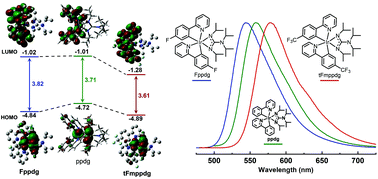Highly efficient phosphorescent organic light-emitting diodes based on novel bipolar iridium complexes with easily-tuned emission colors by adjusting fluorine substitution on phenylpyridine ligands†
Abstract
Two new phenylpyridine derivative-based heteroleptic iridium complexes, (Fppy)2Ir(dipg) (Fppdg) and (CF3ppy)2Ir(dipg) (tFmppdg) with emission peaks of 545 nm and 581 nm, respectively, were designed and synthesized by incorporation of a dipg group (N,N′-diisopro-guanidinate) as the ancillary ligand. Their photophysical, thermal, electrochemical and electroluminescence properties were investigated. The results indicate that the emitting color of phosphorescent complexes can be tuned easily by adjusting their F/CF3-substituted cyclometalated ligands. Simultaneously, Fppdg and tFmppdg show good thermal stabilities, short lifetimes of the triplet state and high photoluminescence quantum yields. More importantly, their almost complete spatial separation of HOMO and LUMO distributions endows both phosphors with an amazing bipolar charge transporting ability, and thus the corresponding doped OLEDs possess desirable concentration-independent and negligible efficiency roll-off features: at a rather wide concentration range of 8–25% doped in the CBP host, both phosphors realize a very high peak external quantum efficiency (EQE) level of >20%, and maintain values of >18% at a practical luminance of 1000 cd m−2.



 Please wait while we load your content...
Please wait while we load your content...